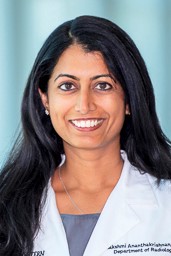by Merissa Harris, MD, Breast Imaging Fellow at Emory University
Women in Radiology Spotlight: Q&A With Lakshmi Ananthakrishnan, MD
Women, especially minority women, continue to be underrepresented in radiology. The ACR® Women and Diversity Subcommittee aims to celebrate diversity in the field of radiology and promotes inclusion at all levels of training and practice. The monthly “Women in Radiology” spotlight aims to highlight women leaders in the field of radiology who have made purposeful contributions that benefit trainees, patients and radiology leadership.
This month recognizes Lakshmi Ananthakrishnan, MD, Assistant Professor of abdominal imaging and Medical Director of computed tomography.
Prior to her career in radiology, Dr. Ananthakrishnan obtained a bachelor’s degree in violin performance from the University of Louisville in Kentucky. She earned her medical degree at the University of Louisville School of Medicine and completed a residency in diagnostic radiology at the Cleveland Clinic. She received advanced training in magnetic resonance (MR) body imaging through a fellowship at Northwestern University School of Medicine in Chicago.
Dr. Ananthakrishnan is an exceptional teacher and mentor with a bubbly personality that can brighten even the darkest reading rooms.
 What has been the most challenging part of your career?
What has been the most challenging part of your career?
I spent a few years in private practice before I joined University of Texas Southwestern (UTSW). When I joined UTSW, I had a lot of "firsts" in rapid succession — I started learning about dual energy/spectral CT for the first time, wrote my first scientific paper and my first book chapter, and I also gave my first presentations to a larger audience. I was learning several new skills at once, and this got overwhelming at times. Similar to many early career physicians, all of this was happening right after I had my first child. Luckily, I had several great mentors who invested time walking me through the process, whether it was giving me feedback on a manuscript, listening to me practice my talks or just being sounding boards.
How did you get involved in leadership and what advice would you give to others wanting to advance in leadership roles?
My fellowship was on body MR, but when I first started working at UTSW, I was asked to work with a small group of technologists and medical physicists to optimize our CT protocols. I ended up learning about the inner workings of a busy CT department and building relationships with the CT team. One thing led to another, and three years later I became Medical Director of CT for our adult hospitals. Don't be afraid to try something new and reinvent yourself.
What is the favorite part of your work?
The people and my hospitals! I work with a fantastic group of people who keep work engaging and fun. Our group serves two hospitals — a county hospital caring for underserved patients, 40% of whom do not speak English, and a tertiary care university hospital where complex patients from all over the state are treated. When I go to work each day, I feel like I am doing something good for our patients.
What advice would you give to those attempting to juggle being a spouse and parent while trying to advance their careers?
Do things on your own terms. This includes saying “yes” to many opportunities and “no” to others. Time is my most valuable commodity, and I've become very selective of how I spend it. At one point, I made a list of the things I enjoy and don't enjoy doing at both work and home; this allowed me to look at ways to offload some of the less fun tasks and spend more of my time on the things I enjoy doing. Optimize your efficiency and ask for help when you need it. The beauty of being at a large academic practice is that whenever I am having trouble with a task or topic, there is someone in my department who has expertise in that area and is willing to help me, and I learn something in the process.
How can radiology improve recruitment of women and promote diversity and inclusion efforts?
I think the lessons learned from COVID-19 has helped this cause — remote reading, the ability to have flex hours and virtual meetings have given all working parents more flexibility. I am lucky to be in a department that understands that being part time and doing research are not mutually exclusive. I do think that there is work to be done to improve the pipeline of women and under-represented minorities in medicine from a younger age. Radiology has something for everyone — the techie, the interventionalist, the artist. We need to market it better. Everyone has a mental image of what a surgeon or a pediatrician does; more organized mentorship programs in radiology could expose younger students to the field of radiology and all that it has to offer.